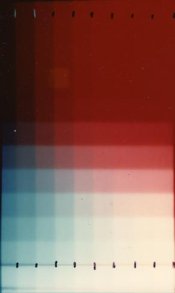Here's a sample of some more recent tooling I've been experimenting with to get more fine grained control over adjusting hue and saturation. The first image is something that I created in the ProPhoto colorspace in photoshop and printed out on a Canon Pro-1000 printer and Canon's PM-101 Photo Paper Pro Premium Matte paper, which the Pro-1000 has a built in paper profile for. To the naked eye, the print looks just like the image in terms of hue and saturation. I'm trusting that the Pro-1000 with this paper is going to render reasonably colormetrically accurate colors. This may or may not be the case, but I don't have any real way to verify one way or the other right now.

Ignore the inner squares for now. The outer squares are each color in the HSL model placed 22.5 degrees apart and with 50% saturation. I did a fair amount of shopping around and found an LED bulb that is 5000K and 90+ CRI and use that bulb to illuminate the paper print of this image. I then take a correctly exposed picture of the print (so far with a digital camera, film to come as soon as I get everything worked out) and use it to generate a hue twist look up table and saturation adjustment table with 22.5 degree waypoints and the in-between values interpolated between waypoints with basic linear interpolation.
The following image is a picture of the print illuminated with the light described above and taken with a Canon EOS M5 camera and the raw CR2 file ran through Simple Image Tools using the generated hue and saturation tables to create a DNG, then pulled into Adobe Lightroom and exported out as an sRGB JPG.
To measure how accurate my lookup tables are, from Lightroom, I export the image out as a ProPhoto TIFF file and pull it into Photoshop and measure the HSL values of each patch.
And here's the same image (slightly different crop) with no hue or saturation adjustments made, so it's reflecting what the camera sensor is seeing before its conformed to the ACES 2065-1 color space with the hue and saturation tables. By itself, it actually looks reasonably fine, it's not until you measure the colors in photoshop that you realize that some adjustment needs to be made. This is our brains "autocorrecting" for us. If I shot this on film, and corrected the mask out and linearized each channel, we'd be seeing how the emulsion renders each hue and with what saturation (not accounting for the white balance difference between the film and the light I used to illuminate this, I still need to work that part out). From there, I can generate a hue and saturation table for that emulsion, which should render each of the patches to within 1 hue degree and +- 1% saturation. This is what's coming down my image processing pipe in the not too distant future.

Now, a fair amount of people will say something like: "looking at patches is all fine and dandy, but doesn't tell you anything about how real pictures will look" or something along those lines. Basically, they're saying they don't trust this sort of thing, but that's primarily because they don't really understand how it works. I can simply provide an example real image using the above methodology. You can do the same thing with a raw scan or picture of color negative film once you've corrected out the orange mask, inverted, and linearized each channel.
The image below was shot on the same Canon EOS M5 and run through Simple Image Tools using the generated hue and saturation lookup tables from the hue patch squares above to make a DNG file, which was then pulled into Adobe Lightroom and exported out as an sRGB jpg file. It was shot late in the day, so the color temperature is a little warm. This is the stop sign on the street right outside my lab. During the summer, it's great because in one picture, I can get a really well known red, green, and blue. Everybody knows what a stop sign should look like, what the sky looks like, and what tree leaves generally look like because most of us see them in all kinds of lighting conditions all the time and they're actually fairly consistently the same color.
I don't think there's anything to complain about as far as hue or saturation are concerned, though, that's just me, and I'm biased.





